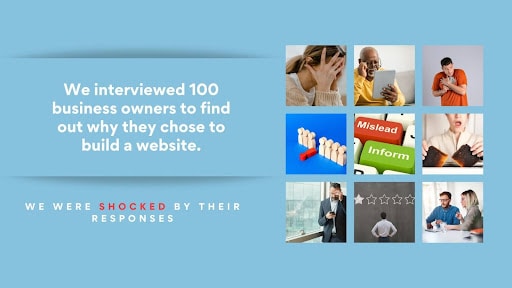
by Anshul Malhotra | May 17, 2024 | Featured
Ever feel like you’re being asked the same question over and over again? As a small business owner, I’m sure you’re used to being asked (or told) why you need a website. But what if we flipped the script? I decided to do something different and reached out to 100 businesses that my team and I deemed did not have an effective website to find out: Why did they have a website in the first place?
Here’s what we found.
The Funny (and True) Responses We Received

When we posed this question to 100 small business owners, we got all sorts of responses. Here are five of the most sadly funny answers:
- “Because everyone else has one.” – Peer pressure is real, even in the business world.
- “My nephew built it for me.” – Family projects can be… interesting.
- “I thought it would magically bring customers.” – Spoiler alert: it didn’t.
- “It was part of a package deal.” – Because nothing says ‘effective marketing strategy’ like a bundled offer.
- “I needed a place to put my cat’s pictures.” – Priorities, right?
Reasons You Shouldn’t Get a Website

Now, let’s get serious. There are many reasons businesses have been sold websites—sometimes websites they don’t need or websites that don’t do anything for their businesses. But most of these reasons can be clubbed into six categories:
- Vanity Projects: Getting a website just to show off, without any strategic purpose.
- Misinformation: Being told that a website alone will solve all business challenges.
- Pressure from Competitors: Feeling the need to have a website just because competitors do.
- Bundled Offers: Buying a website as part of a package deal, without considering its actual value.
- Family and Friends: Creating a website because a relative or friend offered to do it for free or cheap.
- Outdated Advice: Implementing a website based on old strategies that no longer work.
Regardless of the reasons, it’s evident that the website served no purpose for these businesses other than taking up server space, thereby contributing to greenhouse gas emissions.
So, if this is the direction you’re headed, spare yourself the time, money and effort AND spare the planet of the resulting unnecessary greenhouse gas emissions.
However, if you’re still considering getting a website for your business, keep reading to find out what you should be looking for in a website and how it can truly benefit your business.
Reasons You Should Get a Website

After I reviewed the first draft of this post, I realised that the post seemed incomplete without an honourable mention of the RIGHT reasons for actually getting a website.
I know you’ve heard a million of these before, so I’ve summarised the most important ones in 6 short points:
- Sales: A website can act as a 24/7 storefront, enabling customers to purchase your products or services anytime.
- Customer Service: Provide essential information, FAQs, and support options that enhance customer experience.
- Branding: Establish a professional online presence that reflects your brand’s identity.
- Marketing: Leverage SEO, content marketing, and digital advertising to reach a broader audience.
- Credibility: A well-designed website can increase trust and establish your business as a legitimate entity.
- Analytics: Gain insights into customer behaviour, preferences, and trends to make informed business decisions.
Building the Right Website for Your Business

Now, if your business is looking to achieve any of the above goals, you’ll want to ensure that you build a website that’s right for your business. Here are the key points to consider:
- Define Your Goals: Clearly outline what you want your website to achieve—be it sales, lead generation, or customer support.
- Know Your Audience: Understand who your target audience is and design your website to meet their needs.
- Focus on User Experience: Ensure your website is easy to navigate, mobile-friendly, and provides valuable content.
- Invest in SEO: Optimise your website for search engines to improve visibility and attract organic traffic.
- Regular Updates: Keep your website content fresh and up-to-date to maintain relevance and engagement.
What About Existing Websites That Are Just Sitting There?

A common objection I hear is: “I already have a website that didn’t do anything for our business, it’s just sitting there. Our business doesn’t need one. Moreover, I don’t want to throw good money after bad.” Fair point. Businesses have been burnt so many times, having sold websites and marketing services that don’t work, I don’t blame them.
But I wanted to address the dangers of a “dead” website that most businesses don’t realise. In fact, a non-functional website can impact your business negatively to the extent that it’ll turn away customers and deter repeat business – all while you have no idea that it’s doing that in the background.
Let me explain. Imagine having a shop with a broken sign, dusty windows, and outdated displays. Potential customers walk past, assume you’re closed, or worse, that you don’t care about your business and by extension about your customers.
Only in this case, this shopfront is your neglected website which is driving potential customers away, harming your credibility, and giving your competitors an edge all while completely in hidden in plain sight.
Instead of letting your website gather digital dust, consider these actions:
- Audit and Refresh: Regularly review and update your content, design, and SEO strategies.
- Engage: Use your website to connect with customers through blogs, newsletters, and social media links.
- Optimise: Ensure your website loads quickly and is mobile-friendly to retain visitors.
Conclusion
A good website comprises powerful design coupled with solid engineering to help deliver the best results for your business. Whether you’re starting from scratch or looking to revitalise an existing site, understanding the right reasons and methods for having a website is crucial.
We hope this guide helps you build the right website for your business. If you have any questions or need further assistance, feel free to reach out. Happy web building!

by Anshul Malhotra | May 10, 2024 | Featured
In today’s digital age, a website is not just a luxury for businesses; it’s a necessity. Yet, a lot of small business owners remain on the fence about investing in a functional, user-friendly website.
This guide aims to demystify the process of calculating the real Return on Investment (ROI) of a website, helping you make an informed decision about this critical aspect of your business.
The True Cost of Not Having a Website
Imagine walking into an empty store, with no signage, no products on display, and no one to greet you.
That’s essentially what happens when your business has no online presence. In contrast, an outdated or non-functional website is like that store filled with products but in complete disarray, leaving potential customers frustrated and walking out.
The cost?
Lost opportunities, credibility, and revenue.
Excuses, Excuses…

Many business owners still believe that having a social media presence is enough, or that word-of-mouth and traditional marketing methods are sufficient. While these can be helpful in driving some traffic to your business, they cannot match the reach and impact of a well-designed website.
Moreover, not having a website may also signal to potential customers that your business is not keeping up with the times.
Here’s a list of the most common excuses our sales team has compiled after speaking to thousands of businesses around the world.
- “We generate sales via referrals” – That’s great! But what about expanding your referral base exponentially through online visibility?
- “We are busy enough” – Until you’re not. Markets fluctuate, and having a robust online presence can provide a buffer during slower periods.
- “A website doesn’t fit our business model” – It’s 2024 and almost every business model can benefit from an online presence. Yes, even if you sell artisanal marshmallows.
- “We don’t need one” – This statement is as outdated as floppy disks. Everyone needs one.
- “We have one (even though it doesn’t do anything)” – A non-functional website is like having a car without an engine. Looks good, doesn’t go anywhere.
The Case for Investing in a Functional and User-Friendly Website

Investing in a website isn’t just about having a digital ‘open’ sign; it’s about creating a platform for sustained growth. A well-designed website can:
- Increase inbound sales
- Reduce reliance on less reliable sales channels
- Serve as a long-term strategy for growth
- Build trust and credibility with your audience
- Enhance your brand identity
- Improve customer service and satisfaction
Calculating the ROI of Your Website

To calculate the ROI of your website, consider the following formula:
ROI = [(Gains from Investment – Cost of Investment) / (Cost of Investment)] x 100
Where:
Gains from Investment include increased sales, time saved in customer service enquiries, and other long-term benefits.
Cost of Investment encompasses the initial setup, design, development costs, and ongoing maintenance.
Step-by-Step Process:
If that formula looks daunting to you, use the below step-by-step process to calculate the ROI of your website:
- Identify the Average Sale Value: How much is an average sale worth to your business?
- Estimate the Increase in Sales: Based on industry benchmarks, estimate the potential increase in sales from having a functional website.
- Calculate Time/Cost Saved on Customer Service: With a website for answering FAQs and providing information, estimate the time saved for you and your team. Consider how this saved time can be redirected towards more productive tasks.
- Consider Trust Building and Other Long-Term Benefits: While harder to quantify, the trust built through a professional online presence carries immense value. Some ways to quantify your business’s goodwill could be by measuring customer retention rates, length of your sales cycle etc.
- Account for Initial and Ongoing Investment: Include all costs associated with building and maintaining your website.
- Finally, put it all together in the ROI formula to get a percentage value.
What Does a Positive ROI Mean?
A positive ROI means that your website is earning more than what it costs to build and maintain. This is great news and shows that your website is effective in driving business results.
However, keep in mind that a positive ROI does not necessarily mean you should stop investing in your website.
Example Calculation:
Suppose your average sale value is $500, and you estimate an increase of 20 sales per month from your new website. That’s an additional $10,000 per month. If your website saves you 10 hours of customer service time, valued at say, $25/hour, that’s another $250 saved per month.
If your initial website investment was $4,000, with ongoing monthly costs of $200, your first-month ROI calculation would look something like this:
ROI = [ { (10,000 + 250) – 4000 } / 4000 ] * 100
Your ROI = 156.25% in the first month. Calculate this for the whole year, you get a whopping 2975% return on your investment and so on.
I hope that this simplified example demonstrates a significant return on investment, highlighting the potential financial impact of a well-thought-out website.
Final Thoughts
While the thought of investing in a new website might initially seem daunting, the potential returns in terms of increased sales, efficiency, and brand credibility are too significant to ignore.
Remember, in today’s digital marketplace, your website is often the first point of contact between your business and potential customers. Make it count.
Calculating the ROI of your website is more than just crunching numbers; it’s about understanding the value of establishing a strong online presence and laying down the foundation for future growth.
And who knows, with the right approach, your website could become the best employee you’ve NEVER hired – always on duty, never takes a break, and relentlessly working to promote your business.

by Anshul Malhotra | Jan 16, 2024 | Featured
Big news has just shaken the Australian business landscape, and it’s time to take action. Google’s announcement to shut down websites built with Business Profiles has left many local businesses in a digital limbo. This is a significant move that requires your immediate attention and calls for a swift but strategic response to maintain your online visibility and customer reach.
Navigating the Shutdown: Key Action Points
When Google pulls the plug, you can’t avoid the outage. Therefore, your first order of business is to understand the timeline and make the switch seamlessly. Here are the immediate steps to consider:
Understanding the Timeline
Know your deadlines. Google’s Business Profiles service for web creation will be disabled from June 1, 2022. On March 5, 2024, existing sites will no longer be accessible, which means any traffic or engagement through these pages will come to a grinding halt.

Selecting an Alternative Platform
Google has suggested a range of other website builders that you can use to replace your Business Profile site. However, what’s most important is to choose a platform that meets your business needs and is conducive to growth.

Planning Your Site Migration
This is where the rubber meets the road. Migrating your Business Profile data to a new website is crucial but can also be complex. Consider the following factors:
- Review your existing site content and ensure everything you need to migrate is in order.
- Understand the transfer process for your chosen new platform, including any limitations or requirements you need to meet.
- Schedule your migration wisely, taking into account your business’s operational needs and peak times.
Transitioning Gracefully with Our Rescue Plan
For many businesses, the Google Business Profiles website was more than a digital business card; it was a central hub for their online presence. We recognise the urgency and the need for a cost-effective solution that doesn’t compromise functionality. That’s why we’ve developed a tailored rescue plan for local Australian businesses:
Assessing Your Web Design Needs
We understand that not all local businesses have the luxury of an in-house developer or an extensive budget for a website redesign. Our plan involves a needs assessment to determine what kind of website – and what set of functionalities – your business requires.
Unveiling the Specialised Platform

After extensive research and consultation, we’ve shortlisted a range of cost-effective and robust website-building platforms that cater specifically to the needs of Australian local businesses. These platforms offer seamless user experiences for both businesses and potential customers.
Guiding Your Migration
The migration process can be daunting, but with our guidance, it becomes manageable. We provide step-by-step support to transfer your website data, ensuring that your new site is up and running before the March 5th deadline.
Cultivating Your Digital Garden
Creating a new website is not the end; it’s a new beginning in your digital presence. With our plan, we help you understand how to maintain and update your website, and even integrate tools for online purchasing or bookings if your business model requires it.
Why Local Businesses Need to Act Now
The urgent need for this action can’t be overstated. Failure to act will result in a complete loss of your online presence through Google, potentially leading to a drastic drop in local visibility and consumer trust. Timing is critical, and as a local business, you don’t have a moment to spare.
The Impact of Delay
Every day you wait is another day that potential customers may be unable to find you online. This absence could lead to lost revenues and diminished customer loyalty which might be challenging to regain.
The Economic Imperative
In the current economic climate, a robust online presence is not just a convenience; it’s a critical pillar of business continuity and growth. Failing to adapt to this change could mean surrendering vital ground to competitors who make the transition more swiftly.
The Preservation of Your Audience
Your digital presence is an extension of your customer base. By acting now, you can safeguard the relationship you’ve built with your customers. Our plan ensures a smooth transition that keeps your audience engaged and informed.
Your Next Steps: Bringing Our Plan to Life
Make no mistake; this change is significant, but it’s not insurmountable. It’s an opportunity to review, refresh, and re-establish your digital strategy. Our rescue plan is designed to support you through every stage of this critical transition, ensuring that your business not only adapts but thrives in the online sphere.
In the coming months, we will be rolling out detailed resources, webinars, and one-on-one support to help you implement this plan. Your online future begins now – seize the opportunity, and make it your own.
Australian small businesses, it’s time to take control of your online destiny. The clock is ticking, and the future awaits – ready to engage with your customers in a way that’s both responsive and representative of your brand’s innovation.
![Raising Awareness About Medicinal Cannabis in Australia – The Smart and Legal Way!]()
by Anshul Malhotra | Dec 15, 2023 | Featured, OnSite Content Creation, Video Content Creation, Virtual Content Creation
The Role of Therapeutic Goods Administration (TGA)
If you’re battling with the Australian regulatory landscape surrounding medicinal cannabis, don’t pack your bags and move to Amsterdam just yet! The Therapeutic Goods Administration (TGA) might have established stringent rules that prohibit the direct promotion of medicinal cannabis to consumers, but there are still several smart and legal workarounds. While “workarounds” may sound suspiciously like corporate espionage, rest assured we’re on the right side of the law.
Smart and Legal Strategies to Promote Medicinal Cannabis

1. Education for Healthcare Professionals: A Crucial Step Towards Understanding Medicinal Cannabis
Firstly, we should educate our healthcare professionals about medicinal cannabis. Seminars, workshops, and educational materials tailored to doctors, pharmacists, and nurses can help disseminate accurate information about the potential therapeutic applications of medicinal cannabis. So, let’s put those PowerPoint skills to good use!
2. Amplifying Patient Voices: The Power of Advocacy
Secondly, liaison with patient advocacy groups can help amplify the voices of those who have first-hand experience with medicinal cannabis. Whether it’s sponsoring patient support groups, funding research initiatives, or organising public awareness campaigns, we can help them help us!
3. Informative Content Creation: Facts over Fiction
Content creation is the next pillar. This is all about providing high-quality, evidence-based articles, blog posts, and infographics to the public. Remember, our mission is to inform, not to write a new season of ‘Breaking Bad’.
4. The Impact of Public Education Events: A Platform for Knowledge Sharing
Public education events can be a game-changer. They offer a platform for experts to discuss the latest research on medicinal cannabis and its potential benefits. And who doesn’t love a good webinar these days?

5. Media Collaborations: Reaching a Wider Audience
Collaborating with media outlets can also help reach a wider audience. Did someone say media kits, expert interviews, and sponsored educational segments? Now we’re talking!
6. Responsible Use of Social Media: The Art of Subtle Promotion
Social media is a double-edged sword. Whilst direct advertising of medicinal cannabis is a no-no, sharing educational content and participating in relevant discussions is a thumbs-up. But remember, with great power comes great responsibility!
7. Corporate Social Responsibility: Making a Positive Impact
Next on the list is engaging in corporate social responsibility (CSR) initiatives. Funding patient education programs, supporting research initiatives or providing scholarships can demonstrate a company’s commitment to patient well-being and responsible industry practices.

8. Advocacy for Policy Change: Shaping the Future
Lastly, we should not underestimate the power of advocacy. Actively participating in discussions with policymakers and regulatory bodies can help shape future regulations governing medicinal cannabis.
Walking the Regulatory Tightrope
Achieving Awareness and Compliance: A Balancing Act
By employing these strategies, companies can effectively raise awareness about medicinal cannabis and its potential benefits – all within the bounds of TGA regulations. After all, who said navigating the regulatory maze couldn’t be a walk in the park?
by Anshul Malhotra | Feb 7, 2023 | Featured, OnSite Content Creation, Video Content Creation, Virtual Content Creation
If you own a nursery or plant business, you know how competitive the market can be. One way to stand out from the competition is by engaging in buzz-worthy social media content generation.
With the right content, you can reach more potential customers, increase brand awareness, and boost sales.
Let’s take a closer look at why social media content generation is essential for your nursery and plant business.
The Power of Social Media
Social media has become powerful in recent years; it’s no longer a platform for sharing pictures and communicating with friends; it’s also an effective tool for businesses to promote their products and services.
With social media content generation, you can create engaging posts that will attract potential customers and make them want to learn more about what your nursery or plant business has to offer.
Additionally, social media gives you the opportunity to interact with customers, giving them helpful advice on how to care for their plants or answering any questions they might have.
Content Types That Work Best
When it comes to generating content for your nursery or plant business, there are several types of posts that are sure to draw attention from potential customers.
For example, posting photos of beautiful plants is always a great way to engage with followers.
Other ideas include posting instructional videos on how to care for certain plants or featuring customer testimonials about their experiences with your business.
You could even post about upcoming events or special offers that will help bring in new customers and keep existing ones coming back for more!
How To Generate Engagement
Once you’ve created some great social media content, the next step is getting people to engage with it.
To do this, consider using hashtags relevant to your industry as well as tagging other accounts related to your niche – such as influencers or publications – this will help get your content seen by a larger audience than those who follow you on social media. Additionally, replying when someone comments on one of your posts will show that you value their input and care about providing excellent customer service – both important aspects when it comes time for them to make a purchase decision!
It’s clear that generating buzz-worthy social media content is essential if you want your nursery or plant business’s presence online to grow.
By creating engaging posts that highlight what sets your business apart from others in the same space – such as customer testimonials or special offers – plus utilising hashtags and other tactics like tagging influencers to reach a wider audience, you’ll be sure not only to attract potential customers but also keep existing ones coming back again and again!
So what are you waiting for? Get growing with social media content generation today.
















